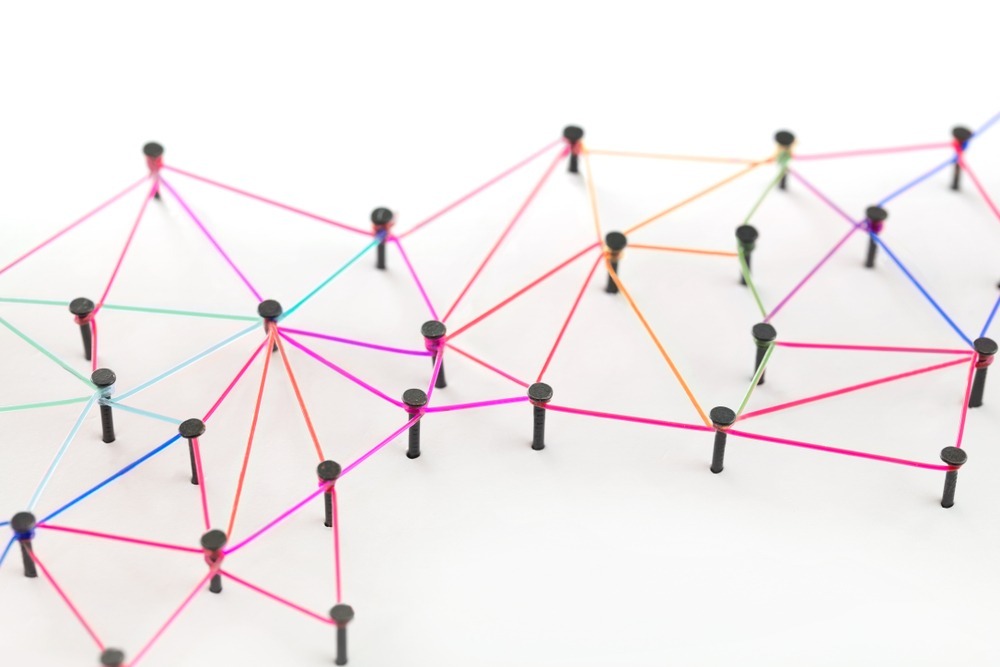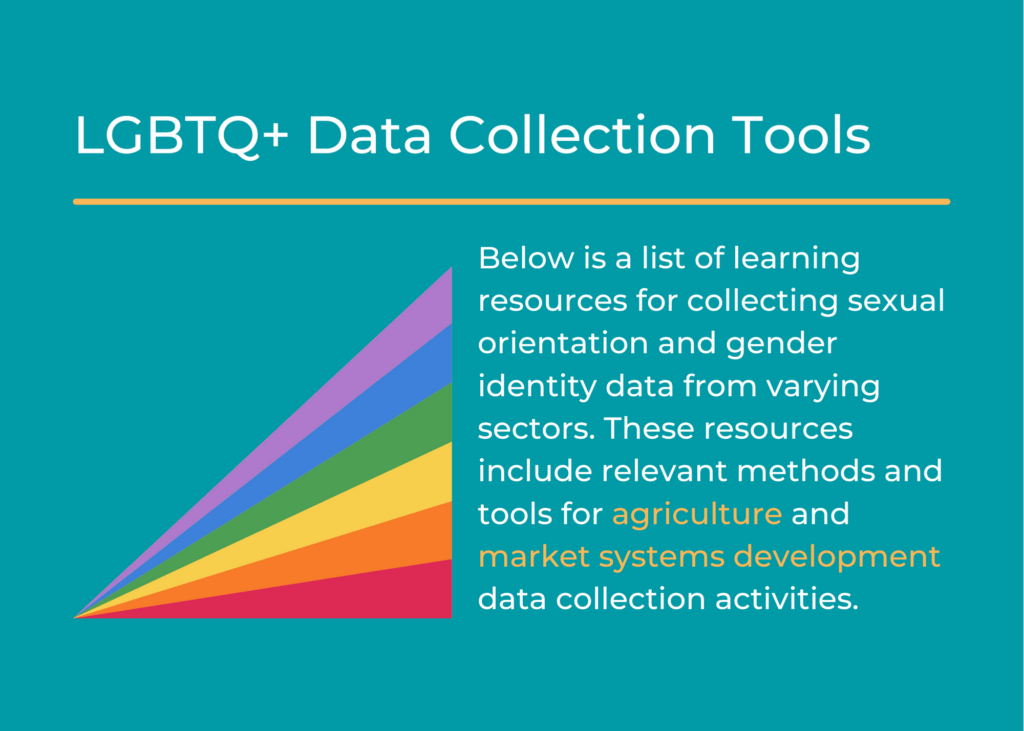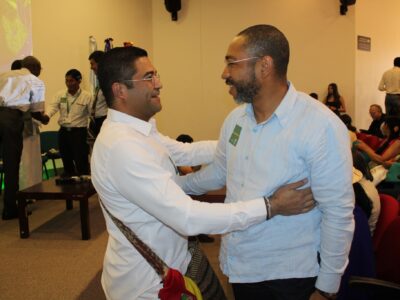
This Pride Month, we explore why the inclusion of LGBTQ+ populations matters in global development from the perspective of international development actors seeking to strengthen LGBTQ+ data collection and use. In previous blogs, we discussed challenges related to inclusion and shared five things to consider when engaging LGBTQ+ populations. In this blog, Jenn Williamson, vice president of gender and social inclusion at ACDI/VOCA, sat down with Mercedes Fogarassy, industry lead at RIWI Corp., and Meri Ghorkhmazyan, senior director of monitoring, evaluation, and learning at Mercy Corps, to talk about the pitfalls of collecting and using LGBTQ+ data by development implementers, particularly those in the agriculture and market systems development sector, and promising solutions.
Why is collecting LGBTQ+ data important?
Mercedes: It’s important from the standpoint of representativeness and accuracy and how that affects program design and implementation.There’s a common misconception that collecting this information is only relevant for programming focused on LGBTQ+ populations, but that is simply not the case. It’s important for us to be able to understand the populations that we are working with, as we work to solve complex development problems. We are at a unique point in the digital development and “data for good” space, where everyone realizes that data itself is important. Data-driven advocacy is a buzzword that gets thrown around, but often that is where it ends, and nothing is done to actually collect the data, let alone identity-disaggregated or intersectional data. Or, even if it’s collected, there are frequently instances where partners or donors do not know how to use it, and it falls to the wayside.
Jenn: The “use” piece absolutely must be there. Sometimes there is a focus on data collection, but there has to be the next step of using it.
“It is not a question of whether LGBTQ+ individuals exist; it is a question of whether we acknowledge that existence and collect information about what is happening to that community. If we are not collecting information about it, we can unintentionally perpetuate exclusion.”
— Jenn Williamson, ACDI/VOCA
Meri: In communities where LGBTQ+ identities are suppressed or invisible, to reveal them and demonstrate the data also promotes cultural and systems change. The other reason we need to have this data is getting to that nuance of intersectionality. If this data conversation is taken out of program conversations, it creates an echo chamber around its supporters. The Gender Mainstreaming Standards, which links operations and programming, was the first initiative to bring that all together.
“So much more education is needed on the safe handling of data and raising awareness that there is value in programming for the community and giving them the equal opportunity to participate as full members of society.”
— Meri Ghorkhmazyan, Mercy Corps
What are the biggest challenges to collecting LGBTQ+ data for development implementers?
Jenn: In the agriculture and market systems sectors, we are behind in developing these processes and procedures because it has generally not been funded or included as part of our programming expectations. This means we lack necessary systems or processes to do it as part of our standard data collection methods. In Honduras, ACDI/VOCA is implementing an inclusive market systems approach that intentionally works to include groups that are marginalized. So, as part of our start-up research, we collected data on challenges and opportunities for women, LGBTQ+ communities, and people with disabilities. We had to modify our data collection processes and create “do no harm” mechanisms. We found challenges, such as LGBTQ+ youth being rejected by their families and migrating to cities where they are at higher risk of experiencing violence and joining gangs. Transgender individuals could not get identification and, therefore, could not access finance or start businesses. And stereotypes influence the roles and employment LGBTQ+ individuals can access. They face greater risk of discrimination in hiring and workplace harassment. That points directly to challenges we needed to address in our programming.
Mercedes: We prioritize anonymity and respondent safety and privacy for security reasons but also because that makes for better data. Individuals will be more likely to be honest. We do not collect any personally identifiable data whatsoever, and that can be a limitation in some ways because we cannot go back to the same individual and ask how something has changed.
There are also challenges around simply crafting the questions and being able to ask for someone’s gender identity or sexual orientation. In some languages, there are no terms for a lot of these identities.
“Knowing when to ask those questions and how to ask them has to be applied differently in different cultural contexts. It is not going to be a ‘one size fits all’ situation, and it takes time.”
— Mercedes Fogarassy, RIWI Corp.
What are some safe, effective ways to overcome these challenges?
Meri: I think strides have been made just by donors requiring a gender and social inclusion assessment for projects. Maybe the time has come where this also needs to be at the country level as an agenda driven by governments. In some countries, we are successful in that, and, in others, we will never be — not in the near future. But collecting data in every country about the needs of excluded groups will be a war won not just for the LGBTQ+ community but all minority communities.
“When you are deciding to collect certain data and ensuring that your data collection form offers opportunities for the LGBTQ+ community to self-identify safely, your underlying message is, ‘You are welcome in this program. We want to know who you are.’ That narrative needs to be amplified.”
— Meri Ghorkhmazyan, Mercy Corps
Jenn: In addition to collecting research through formal studies, offer opportunities for project participants to self-identify in safe ways. For example, instead of having staff report the number of men and women in attendance at an activity based on their observation or names on a sign-up sheet, consider alternative ways to collect this data from the participants themselves. Methods could include asking participants to fill out an attendance card or evaluation form that includes a few demographic questions, including gender. The gender question could be formatted as a selection of options that includes diverse gender identities or leaves the question open for the respondent to fill in their preferred response.
It is also essential to engage LGBTQ+ organizations and groups. A big challenge is that we are not in private settings, like clinics. We are often interviewing people in public places like fields, markets, businesses, and cooperatives. In addition to providing important insights into the perspectives of sexual and gender minorities, local organizations can provide insight into what is an effective and safe solution to reach them.
“Development implementers must find ways to access and bring in the voices of sexual and gender minorities in the contexts where we work. Local LGBTQ+ organizations offer invaluable insights into the diverse needs and experiences of this community and serve as key partners in developing solutions.”
— Jenn Williamson, ACDI/VOCA
Mercedes: Starting locally and developing those relationships is going to be the best way to figure out the challenge of translations and linguistics. Having those networks would make for better, more reliable data down the line.
“It’s about having those nuanced conversations in advance with people who know the situation because they live and breathe it.”
— Mercedes Fogarassy, RIWI Corp.
Jenn: Market systems programs often focus on organizations, businesses, and financial impacts for their target audiences and what they are seeking to strengthen. But we as implementers need to pause and say, “The institutions we are working with are serving people. Small businesses are owned by people. People access loans.” And we need to make sure we ask who is accessing those businesses or loans, and who isn’t? We need to make sure we are looking at groups of people, including gender and sexual minorities, who may not be able to access and act in the same ways. Eventually, I would also like to see us working with private sector partners to understand how to safely collect and use data that includes more diverse understandings of gender. And the next phase would be to share the data — anonymize it and contribute it to a larger data set that can be accessed and used across the industry to strengthen how businesses and services operate. We could learn so much in just one country, let alone multiple countries.

Best Practices for Asking Questions about Sexual Orientation on Surveys (SMART), The Williams Institute at UCLA
Best Practices for Asking Questions to Identify Transgender and Other Gender Minority Respondents on Population-Based Surveys (GenIUSS), The Williams Institute at UCLA
Data Collection Methods for Sexual Orientation and Gender Identity, The Williams Institute at UCLA
Data Feminism, Catherine D’Ignazio and Lauren F. Klein
LGBT Data Collection, Center for American Progress
LGBTQ-Inclusive Data Collection: A Lifesaving Imperative, Human Rights Campaign
Ready, Set, Go! Guidelines and Tips For Collecting Patient Data on Sexual Orientation and Gender Identity (SOGI), National LGBTQIA+ Health Education Center
Check out the full 2021 Pride Month blog series:
- Why the Inclusion of LGBTQ+ Populations in Agriculture and Market Systems Matters, Part 1 and Part 2
- Experts Discuss Opportunities for Expanding LGBTQ+ Inclusion in Agriculture and Market Systems Development





